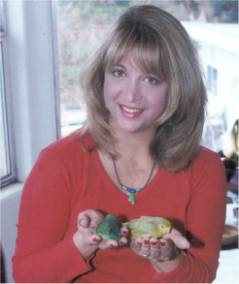Hi Sandee,
You have a great website, thanks for putting it together.
I have a “Medium Blue” Parrotlet (male) and your site is the only one to discuss this variation.
What, if anything, do you know about this color mutation? In your experience does it seem to be dominant or recessive?
I have also seen Green Parrotlets with the same gray coloration. Do you suspect it is the same or similar gene?
This is my Louie (and his dilute girlfriend Lulu):
Thank you,
Paul in Massachusetts
Dear Paul:
Thank you for your email.
It is important to remember when dealing with color mutations that it is not the color that determines the mutation, it is the gene. All blue mutation parrotlets have the same gene so they are all blues – not light blues, medium blues, dark blues…those are just various tones and have more to do with sex and subspecies rather than the mutation. Indeed, even the ‘turquoise’ mutation is not a turquoise but actually a partial-blue because the original birds were blues imported from Europe.
I always tell people to think of blond hair – we have platinum blond, honey blond, dirty blond, strawberry blond – all different tones and variations on color but they are all blond; all the same gene. The blues (and dilutes for that matter) are all the same color mutation but each individual bird can have variety of color tones. In the picture you provided, for example, the bird is clearly a male who has the Pacific subspecies of lucida in it. That is why the blue mutation manifests itself in darker tones and has a lot of gray especially on the back and wings. This is clearly the influence of the subspecies and not the mutation.
Also, the female in that picture is a dilute-blue not a dilute. “Dilute” is the term for the bird formerly called “American yellow”. If you breed her to your male and your male is split to dilute – you will get dilutes, blues and dilute-blues. If your male is not split to dilute, you will only get blue offspring but they will be split to dilute. This is because ‘dilute-blue’ is combination of blue and dilute.
It is unfortunate that most people who have parrotlets these days have never seen a wild-caught parrotlet. I worked with wild-caught species of parrotlets for more than a decade and saw only pure species and subspecies. Since we have not imported wild-caught normal birds since 1992 most of the subspecies were commingled. This was especially true after color mutations were added to the Captive Bred List of Birds Allowed to Be Imported (by petition of the International Parrotlet Society btw). Color mutations have flooded the market and it is almost impossible to find a pure normal Pacific that doesn’t carry some color mutation gene. As for pure species or subspecies, unless someone was breeding parrotlets before 1993 they have probably never seen a pure normal Pacific parrotlet or the Columbian subspecies. You can got to my website and read about the lucida subspecies of the Pacific http://www.parrotletranch.com/thelostlucida.html I think you will have a much better understanding.
I hope this helps!
Sincerely yours,
Sandee L. Molenda, C.A.S.
The Parrotlet Ranch, Owner, www.parrotletranch.com
Join the International Parrotlet Society, – the World’s Largest and Oldest Parrotlet Organization www.internationalparrotletsociety.org
A Chattering Bird Builds No Nest.
Camaroonian Phrase
Sunday, March 20, 2011
"Medium Blue" Pacific Parrotlet
Subscribe to:
Post Comments (Atom)




No comments:
Post a Comment
Note: Only a member of this blog may post a comment.